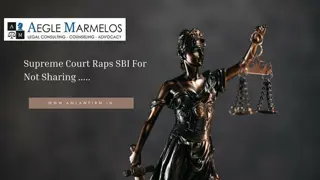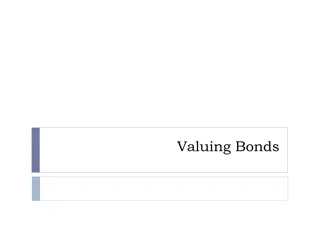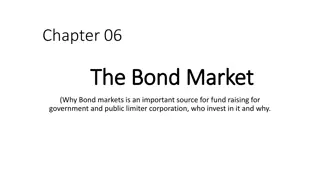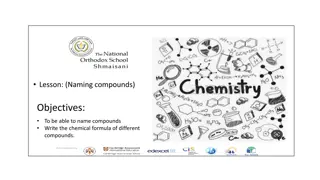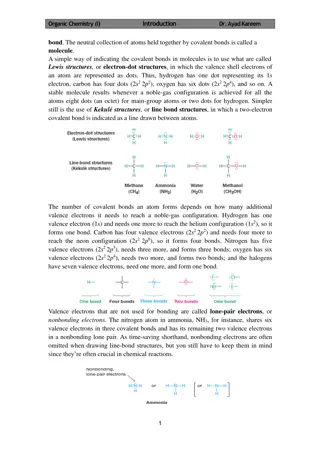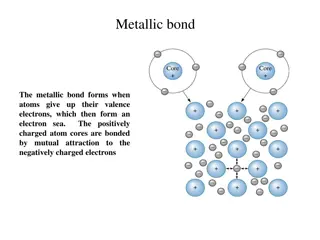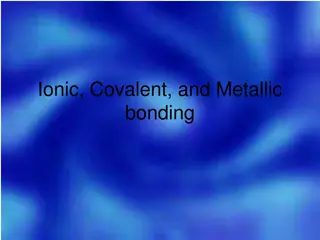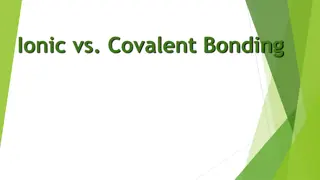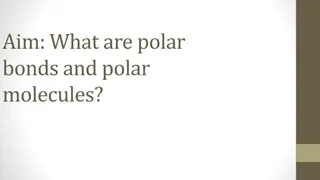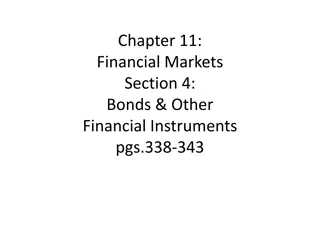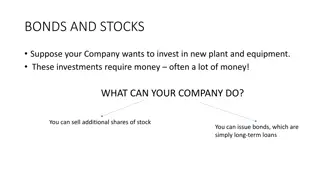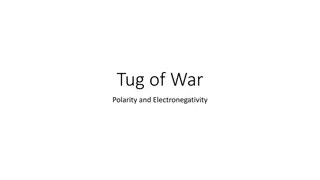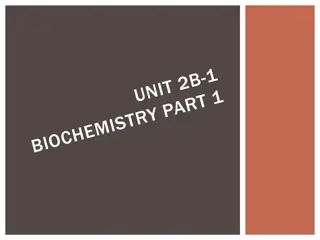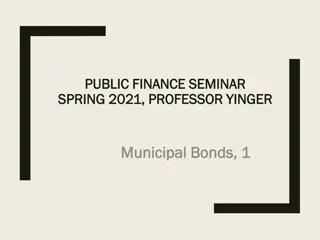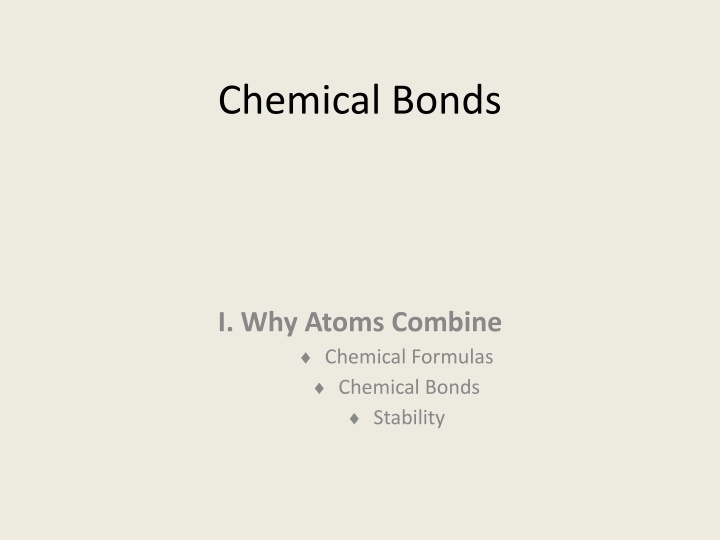
Chemical Bonds
Explore the world of chemical bonds, including how atoms combine to form molecules, the significance of chemical formulas, different types of bonds such as ionic and covalent, and the role of stability in bond formation through electron transfer or sharing. Dive into the basics of chemical bonding in this informative guide.
Download Presentation

Please find below an Image/Link to download the presentation.
The content on the website is provided AS IS for your information and personal use only. It may not be sold, licensed, or shared on other websites without obtaining consent from the author. If you encounter any issues during the download, it is possible that the publisher has removed the file from their server.
You are allowed to download the files provided on this website for personal or commercial use, subject to the condition that they are used lawfully. All files are the property of their respective owners.
The content on the website is provided AS IS for your information and personal use only. It may not be sold, licensed, or shared on other websites without obtaining consent from the author.
E N D
Presentation Transcript
Chemical Bonds I. Why Atoms Combine Chemical Formulas Chemical Bonds Stability
A. Chemical Formula Shows: 1) elements in the compound 2) ratio of their atoms H2O 1 oxygen atom 2 hydrogen atoms
B. Chemical Bond Strong attractive force between atoms or ions in a molecule or compound. Formed by: transferring e- (losing or gaining) sharing e-
C. Stability Stability is the driving force behind bond formation Elements can gain, loose or share electrons to become stable Octet Rule most atoms form bonds in order to have 8 valence e- want a full outer energy level like the Noble Gases
C. Stability Transferring e- Sharing e-
Chemical Bonds II. Kinds of Chemical Bonds Ionic Bond Covalent Bond Comparison Chart
A. Ionic Bond Attraction between 2 oppositely charged ions. Ions are charged atoms. A cation is a positively charged ion (Forms when an atom loses an e-) Formed by metals. An anion is a negatively charged ion (Forms when an atom gains an e-) Formed by nonmetals. Ions are formed by transferring e- from a metal to a nonmetal.
A. Ionic Bond ions form a 3-D crystal lattice NaCl
B. Covalent Bond Attraction between neutral atoms. formed by sharing e- between two nonmetals
B. Covalent Bond covalent bonds result in molecules Cl2 H2O NH3
B. Covalent Bond Nonpolar Covalent Bond e- are shared equally usually identical atoms
B. Covalent Bond Polar Covalent Bond e- are shared unequally between 2 different atoms results in partial opposite charges + -
Both types of bonds Some compounds have a mixture of ionic and covalent bonds. These generally contain POLYATOMIC IONS. Polyatomic ions are groups of non-metal elements bonded covalently together that have an overall charge Generally polyatomic ions will form an ionic bond with metal. They are easy to recognize because they have three or more elements in the compound. Examples: Na3PO4, Al2(SO3)3
C. Comparison Chart IONIC COVALENT shared between nonmetals transferred from metal to nonmetal Electrons Types of Elements Metal and Nonmetal Nonmetal ONLY
C. Comparison Chart Melting point: Ionic HIGH / Covalent low Soluble in water: Ionic YES / Covalent not usually Conduct electricity: Ionic YES (when melted) / Covalent: no Other properties: ionic tend to be brittle / usually solids
Practice What type of compound is show or described below? 1. Ionic 2. Covalent 3. Covalent 4. Ionic 5. Both (polyatomic) 6. Ionic 7. Covalent 8. Both (polyatomic) 9. Covalent 1. NaCl 2. CO2 3. H2O 4. Fe2O3 5. Ga(C2H3O2)3 6. Metal and non metal 7. 2 non metal 8. 3 or more elements 1. Doesn t dissolve in water
Chemical Bonds III. Naming Molecular Compounds Molecular Names Molecular Formulas
A. Molecular (Covalent) Names Write the names of both elements. Change the final ending to -ide. Add prefixes to indicate subscripts. Only use mono- prefix with second element.
PREFIX mono- di- tri- tetra- penta- hexa- hepta- octa- nona- deca- SUBSCRIPT 1 2 3 4 5 6 7 8 9 10 Covalent Naming Prefixes
A. Molecular Names CCl4 carbon tetrachloride N2O dinitrogen monoxide SF6 sulfur hexafluoride
B. Molecular Formulas Write the more metallic element first. Add subscripts according to prefixes.
B. Molecular Formulas phosphorus trichloride PCl3 dinitrogen pentoxide N2O5 dihydrogen monoxide H2O
B. Molecular Formulas The Seven Diatomic Elements Br2 I2 N2 Cl2 H2 O2 F2 In nature, these elements are never alone!
Chemical Bonds IV. Naming Ionic Compounds Oxidation Number Ionic Names Ionic Formulas
A. Oxidation Number The charge on an ion. Indicates the # of e- gained/lost to become stable. 1+ 0 2+ 3+ 4+ 3- 2- 1-
Oxidation Chart Group # 1 2 13 14 15 16 17 18 Valence e- 1 2 3 4 5 6 7 8 Oxidation # -2 -1 -3 0 +1 +2 +3 +/-4
B. Ionic Names Write the names of both elements, cation first. Change the anion s ending to -ide. If there is a polyatomic ion, write the name of the polyatomic ion.
B. Ionic Names NaBr sodium bromide Na2S sodium Sulfide SnCl4 Tin chloride
C. Ionic Names to Formulas Look at the given name Write each ion. Put the cation first. Overall charge must equal zero. If charges cancel, just write the symbols. If not, crisscross the charges to find subscripts. Use parentheses when more than one polyatomic ion is needed.
Writing Ionic Formulas Crisscross method. IF the charges don t balance the number of the charge becomes the subscript for the opposite element or polyatomic ions. Example Mg +2 N-3 = Mg3N2 The charges BALANCE thus disappear.
Writing Formulas Example 2: Al+3 S-2 Remember to use parentheses when more than one polyatomic ion is needed. Al2S3 Example 3: Na+1 I-1 NaI Remember If charges cancel, just write the symbols
C. Ionic Formulas potassium chloride K+ Cl KCl magnesium Phosphide Mg2+ P-3 Mg3P2 aluminum oxide Al3+ O Al2O3
Mixed Names to Formulas Ionic Names NO PREFIXES Must write ions and balance charges. Remember NO charges in chemical formulas. Will see polyatomic items. (end in ite or ate) Calcium phosphide Ca+2 P-3 Ca3P2 Covalent Names Have prefixes in the name Use the prefix to write the chemical formula Write what the name tells you to write. Dinitrogen hexaphosphide N2P6
Mixed Formula to Names Ionic Formulas Have metal and nonmetal Write the name of each element Change the end of the 2nd element to ide IF 3 or more elements in compound use polyatomic list to fide its special name. K3N Potassium nitride Covalent Formulas Have ONLY nonmetals Write the name of each element Change the end of the 2nd element to ide ADD PREFIXES to show the number of atoms CO Carbon monoxide
Properties of Ionic compounds From by transferring electrons Metals lose electrons form positively charged cations Nonmetals gain electrons Form negatively charged anions Are crystalline solids (form crystals) with very high melting points Are soluble in water (can dissolve) When dissolved in water will conduct electricity
Properties of covalent compounds Form by sharing electrons Between two neutral nonmetal atoms Most are liquids or gases Also called molecules Many covalent compounds have no odor Have very low melting points Most are not soluble in water Do not conduct electricity
C. Comparison Chart IONIC COVALENT shared between nonmetals low transferred from metal to nonmetal high Electrons Melting Point Soluble in usually not yes Water Conduct Electricity yes no (solution or liquid) crystal lattice of ions, crystalline solids Metal and Nonmetal molecules, odorous liquids & gases Nonmetal ONLY Other Properties Types of Elements

